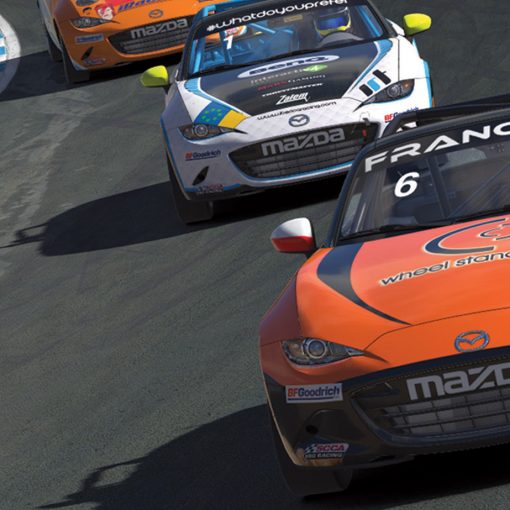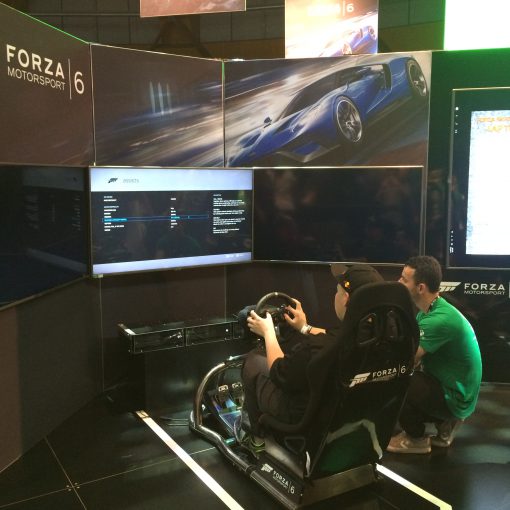iRacing’s road career offers a multitude of racing series, especially at the D and C license level. Choosing a proper career path can be a bit confusing, hence this guide.
How to increase license level
Everybody starts out at Rookie level with a safety rating of 2.50, in all four careers (oval, road, dirt oval, dirt road). There are five license levels above Rookie: D, C, B, A, and Pro. Advancing up to A works the following way:
- You need to meet the Minimum Participation Requirement (MPR) of four races or four time trials in your current license class.
- Your safety rating needs to be 3.00 or better. If you’re a rookie, you are immediately promoted to D upon reaching 3.0. In D or higher, you are promoted at the end of the season.
- You are promoted mid-season if your safety rating is 4.00 or better. This means that you easily climb multiple classes in a single season as long as you drive safely and fulfil the MPR.
Pro rating is based on results and reserved for the very best drivers.
As you can see, promotion up to A is based only on safety rating. You don’t need to be fast, you just have to be a safe driver. This means that you can be in A class with a pretty low iRating (which is based on your results) – whether it’s fun to be there competing against much faster drivers in another question. The safety rating you gain (or lose) each race is dependent on the number of incidents and the number of turns in a race, so having zero incidents will yield a higher SR gain in a long race than in a short race. In higher classes, you lose SR more quickly – another reason not to climb too quickly.
You can always race in races of lower license levels. A race needs to have at least six entries to become “official”, i.e. to count for iRating. A season consists of twelve weeks and week 13 (with special events), a new week starts on Tuesday.
Rookie
Since season 4 2020, there’s only one rookie road series: The Global MX-5 Cup. The place to begin, small grids (12 cars max) and short races of approx. 15 minutes. As of season 1 2020, it has been upgraded to ND2 specs (more power) and is on NTMv7, making it even more fun to drive.
The MX-5 Cup races only on free tracks, with a race every hour on the hour. The series is very popular and splits almost always.
What’s a split? There’s a maximum of 1 cars in an MX-5 cup race. When there are more drivers than this, they are split into multiple races based on iRating, which means that people of similar speed are likely to race together. Yes, this means that a fast Rookie may be racing against an A class driver if both have similar iRatings.
D class
Quite a number of new race series are opened up by promoting to D class:
- The Sim-Lab Production car challenge. Used to be rookie-class, but was moved to D class for season 4 2020. This is a multi-class series with the MX-5, Pontiac Solstice, VW Jetta (all free), and Ford Mustang (paid). The MX-5 is by far the most popular, and I recommend driving this car. Races are of varying length, including a few longer races with a pit stop. This makes the SLPCC a great series to learn in.
- Pure Driving School Formula Sprint: Relatively recent series with the USF 2000 formula car.
- BMW 12.0: Short 12 minute races, alternates between the M8 GTE and the M4 GT4. Uses the M4 in season 1 2021.
- Turn Racing Touring Car Challenge: Introduced in season 4 2020, uses the Audi RS3 LMS on mostly free tracks in short 15 minute races. More popular than the MWC that used to be the only place were you could race the Audi.
- Ferrari GT3 Challenge: Uses the Ferrari 488 GT3 in short 15 minute races.
- Skip Barber: Very popular series and the logical choice if you want to do open wheel racing. The “Skippy” is another momentum car, so a logical progression from the MX-5.
- Formula Renault 2.0 Championship. Open wheel, the Skippy (see above) is much more popular.
- Ruf GT3 Challenge: A series with an older car, not very popular. The car cannot be raced in other series. 30 to 45 minute races.
- Spec Racer Ford: The SRF is a free car. Lightweight but with low horsepower, it is also a momentum car like the MX-5. It is more unstable under braking though and in this regard a good preparation for the GT3 and GTE cars, which also tend to be less forgiving than the MX-5.
- Fanatec Global Challenge: Cadillac CTS and Kia Optima, both free cars. The Caddy has a lot more power than the MX-5, driving it is a good introduction to driving a high-horsepower car like the GT3 and GTE cars. The grid size is quite large and rolling starts are used. Race length 25 minutes, decent participation.
While all D class series use paid tracks, most of them are on a free track at least once in a 12-week season. This means that you can use the free cars to get your four-race MPR, and increase your safety rating in the Rookie series, to promote to C-class without spending money on content. Even better, since season 4 2020 there are two D-class series (SLPCC and Touring Car Challenge) that use mostly free tracks, meaning that you can earn participation credits (US$4 for D- and C-class if you participate in at least 8 weeks of a series) without buying much content.
C class
The following race series are C class:
- IMSA Michelin Pilot series: Audi RS3 LMS TCR, and two GT4 cars, the Porsche Cayman and the BMW M4. 30 minute races with rolling starts. Popularity has suffered a bit, especially since there’s a standalone D-class series for the Audi.
- Radical Racing Challenge: Single-make series, free car. Fast and high downforce, but fragile. Can be a cheap introduction to faster cars.
- Kamel GT Championship: A series with historic cars, the Nissan GTP ZX-T and the Audi 90 GTO. Not very popular, but with a dedicated group of racers. 40 to 60 minute races.
- Advanced Mazda MX-5 Cup: Here’s the trusty MX-5 again, now in an open setup series on mostly paid tracks and with a larger grid size. Popular and good competition, so even if you focus on another series it’s always worth doing a race in a week on a track you own.
- Apex Racing Academy F3 Championship: Fast high-downforce formula car.
- Indy Pro 2000 Championship: Relatively recent addition, races both on ovals and road tracks.
- V8 Supercars Series: Holden Commodore and Ford Mustang, for Australians 😉
- Porsche iRacing Cup: Currently the only series where you can race the 911 GT3 Cup, quite popular for a single-make series. The car is not easy to drive but very rewarding. Approx. 25 minute races.
- Heusinkveld GT Challenge: Ford GT, Corvette, Aston Martin DBR9. A bit of an odd one, this one is for racing older cars and thus not popular. 30 minute races.
- Grand Prix Legends: Uses the classic 1967 Lotus 49, which is reputed to be difficult to drive. Unfortunately, unlike the original Grand Prix Legends games, there are no old race tracks in iRacing, so you’ll race on more modern tracks.
- VRS GT Endurance Series: GT3 cars in three-hour races every Saturday and Sunday.
- Dallara Formula iR: New for season 1 2021, introducing a new (fictional) car that is essentially what a modern Formula 1 car would look like if they still used naturally aspirated V10 engines.
As you can see, C class offers a wide variety of race series. This does of course lead to fragmentation, and several series suffer from poor participation outside of peak hours. While more popular series offer larger grids, the racing can be a bit rough. The smaller series often have a dedicated and close-knit community and thus cleaner racing.
B class
B class, on the other hand, features only six series:
- Verizon INDYCAR series: Like real INDYCAR, a mixed road/oval series.
- IMSA Sportscar Championship: Often requested, finally moved from C to B class for season 1 2021, featuring large grids of LMP2, GTE and GT3 cars and fierce competition. 45 minute races. Was very popular in C class, we’ll have to see how B class works out.
- VRS GT Sprint Series: GT3 cars in 40 minute races, the premier GT3 series on iRacing.
- GTE Endurance Series: All GTE cars in 90 minute races, races only every other Saturday and Sunday.
- Classic Lotus Grand Prix: Another historic series, with the 1978 Lotus 79. Races are quite long.
- Endurance Le Mans Series: Featuring LMP and GTE cars, team racing due to 360 minute race length.
- Formula 3.5 Championship: Formula Renault 3.5, the only B class open-wheel series.
A class
As of season 1 2021, there are three A-class series:
- Le Mans Series: two LMP1, the Dallara P217 and several GTE cars in 60 minute races.
- Le Mans Endurance Series: same cars in 6-hour team races, races only every other Saturday and Sunday.
- Grand Prix Series: McLaren MP4-30 Formula 1 car.
Possible career progressions
- GT3: MX-5 – Global Challenge (or Ferrari Challenge) – Porsche Cup – GT Sprint
- GTE: MX-5 – BMW 12.0 – Michelin World Challenge – IMSA – Le Mans
- Open wheel: MX-5 – Skippy – Formula 3 or Formula iR – Formula Renault 3.5 – Grand Prix
- Touring cars: MX-5 – TCC – Michelin World Challenge
- Free to B (free content only): MX-5 – SLPCC/SRF/Global Challenge Cadillac – Advanced MX-5/Radical
I do not think it is desirable to progress to A class for the sake of getting an A class license. The best racing can probably be had in D and C class, while the MX-5 series and SLPCC have very good participation and race every hour. You’ll probably have the most fun when concentrating on one or two series and getting in the occasional race in another series using a car and track you own. There is nothing wrong with sticking to the Advanced MX-5 in C class, and you might have more fun there than being frustrated with a much faster more difficult to drive GTE car. Likewise, the Skippy has a very loyal following. The big advantage of the popular series is that there will be multiple splits in peak times, meaning that you’ll race against people with similar iRating and thus similar speed. This is much more fun than racing in a series with just a few drivers (and thus a single race) of potentially very differing skill and speed. You can always drive in the MX-5 in the Global Cup or SLPCC and have fun there while learning to drive a faster car in another series.



One thought on “Progressing through iRacing’s road career”
Good stuff! As a road racer there are so many options, I’ve recently gone back to C and D (especially the mx5!) as a a B driver pending A and felt a bit odd.. was looking for some reference.. seems it’s not a crazy as I thought!